(This article was originally published by ISEAS – Yusof Ishak Institute under the ISEAS Perspective 2022/28, 18 March 2022.)
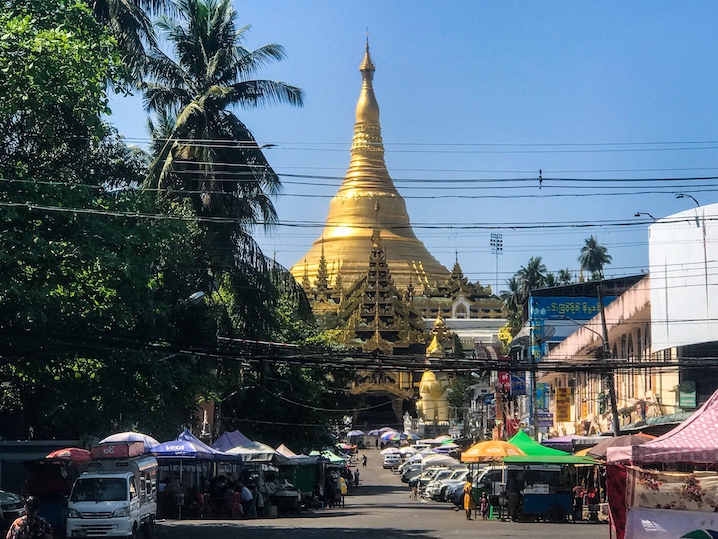
EXECUTIVE SUMMARY
◉ Political stakeholders tend to view the National Unity Consultative Council (NUCC) as key towards achieving a parallel governance system in the medium term, and as part of a solid foundation for a long-term federal democratic solution to Myanmar’s problems.
◉ The strong commitment shown by the NUCC stakeholders has allowed for compromises and incremental and workable solutions and for it to function as a unifying force to challenge the military.
◉ In principle, a qualitative and quantitative content analysis of Federal Democratic Charter I and II show that the NUCC has been able to reach a consensus in support of ethnic minorities’ struggle for equality and over identity issues.
◉ However, the sequencing problem in the NUCC stakeholder dialogue including the formation of NUG before the completion of FDC Part II, and the lack of clarity on the check-and-balance function of the NUCC, worry some stakeholders where the CRPH’s and NUG’s priorities are concerned.
◉ Going forward, stakeholders’ continuous strong commitment in the fight against the military, in building a solid foundation for a federal and democratic union, and in making incremental compromises would make political coalition long-lasting.
INTRODUCTION
A week before the one-year mark of the 1 February 2021 military coup in Myanmar, the National Unity Consultative Council (NUCC) organized an online “People’s Assembly”. The NUCC is a political alliance of pro-democracy forces and ethnic armed organizations serving as a decision-making body in the parallel governance system. Joined by nearly 400 representatives from different political groups, the assembly ratified the Federal Democracy Charter (FDC), reaffirmed the formation of the interim National Unity Government (NUG), and rejected military rule in Myanmar. This assembly thus ushered in a new era of unchallenged political legitimacy for the NUCC and NUG and accepted federal democracy as a foundational principle for the country’s future.
Myanmar’s real struggle, however, is not what international media commonly portrays as the story of fighting between the military and anti-military forces. The conflicts are more than that, and are instead reflective not merely of state-society democratic contention but also of nation-building failure. In one of the world’s most ethnically diverse countries since its independence, minority groups in Myanmar have since its independence in 1948 suffered from suppression of their participation in (1) the political process (and even large-scale disenfranchisement in the 2020 elections), (2) the distribution of resources and economic goods, and (3) their social, cultural, and religious rights under Bamar majoritarian rule. The Bamar-dominated autocratic state and nation-building failure are persistent reasons for ethnic groups to take up arms against the central government and seek greater autonomy.[1] Therefore, viewing the emergence of the NUCC as a mere attempt to topple the junta falls short of appreciating the underlying cause of Myanmar’s crisis. Moreover, this snapshot view discounts the struggles and challenges that have been occurring within the NUCC in its effort to create a federal and democratic future. The road to the federal democratic vision of NUCC is not without its challenges. While most of the political forces within the NUCC share similar sentiments about the country’s federal and democratic values and goals, they face a number of serious challenges. Nonetheless, stakeholders have demonstrated their strong commitment to fight against the military through their incremental solutions to resolve such constraints and avoid the potential pitfalls from practical constraints.
THE EMERGENCE OF A MULTI-ETHNIC PARALLEL GOVERNANCE SYSTEM
The origin of NUCC can be traced to the days following the 2021 military coup. Representatives who had won seats in the November 2020 election formed the Committee Representing Pyidaungsu Hluttaw (CRPH) on 5 February 2021 to serve as an elected legislative body.[2] It then quickly established an interim government with four acting ministers [3] and an acting vice-president.[4] The CRPH then abolished the military-drafted 2008 Constitution and published the first part of the Federal Democratic Charter (FDC) on 31 March 2021.[5] This part of the FDC spells out shared values and principles, the formation of the interim NUG, and the establishment of the NUCC to coordinate different political forces and to work with the NUG. As declared in FDC I, the NUG was formed on 16 April 2021 with one vice president, one prime minister and 11 cabinet ministers.[6]
Though formed in early March 2021, the NUCC was officially launched only in November 2021.[7] FDC I indicates that NUCC members include CRPH representatives who are overwhelmingly from the NLD, ethnic armed organizations (EAOs), civil society organizations and groups affiliated with the Civil Disobedience Movement[8] and ethnic resistance organizations, and ethnic political parties—many of which had had troublesome relations with the NLD while the latter was in power. NUCC members went through different rounds of discussions over the contents of FDC II, which serve as the basis for the formation of the Interim NUG, and lays out the political road map outlined in FDC I. The People’s Assembly in January 2021 ratified FDC I and II, and formalized the NUCC as a multi-ethnic and pro-democratic alliance to govern the country’s political transition, while recognizing the NUG as the interim government.
In Myanmar’s history of resistance, the alliance of EAOs and pro-democratic forces is not unusual. The Democratic Alliance of Burma (DAB)[9] and the National Council Union of Burma (NCUB)[10] are examples of such struggles against the military in the past. However, the multi-ethnic and pro-democracy forces alliance in the NUCC are significantly different. Support for ethnic minorities’ struggle for equality and identity issues, as well as the Bamar majority’s sensitivity to minority concerns are presently unprecedentedly high. The following section explains these issues as setting the federal democratic principles and discusses how the NUCC has managed to pull together diverse interests and to move forward despite practical constraints.
PRINCIPLE CONSIDERATIONS: FEDERAL AND DEMOCRATIC FUNDAMENTALS
This section of the paper employs content analysis to identify the outcomes of the NUCC’s discussions. Its primary focus is to identify the extent to which fundamentals of federal and democratic principles are reflected in FDC I and II against the backdrop of the military-drafted 2008 Constitution, and provides a better understanding of how NUCC’s stakeholders perceive federal and democratic principles against the military’s old textbook, the 2008 Constitution.
The analysis uses words and phrases as units of study. The quantitative content analysis first counts specific words in FDC I and II. It also examines these words in phrases, since understanding the significance of these words depends on their specific contexts. It particularly identifies words and phrases that fall under five categories of federal principles: (1) Federal and Democratic Visions, reflecting federal and democratic values; (2) Identity, Diversity and Inclusiveness Issues, or the degree of openness to and acceptance of the unique characters and identities of ethnic groups, diversity in religion, culture and language; (3) Shared Rule/ Self Rule, indicating shared rule and a high degree of autonomy for regional governments; (4) Separation of Powers, in which power is distributed among three branches of government to maintain checks and balances; and (5) Conflict Resolution, which focuses on the means to topple the military dictatorship while building a federal democratic union as the ultimate goal. These categories help interpret the NUCC’s application of federal principles in its discussions in order to produce FDC I and II. They also highlight the degree of difference these documents attempt to make in comparison with the 2008 Constitution.
Table 1. Words and Phrases in the Federal Democracy Charter
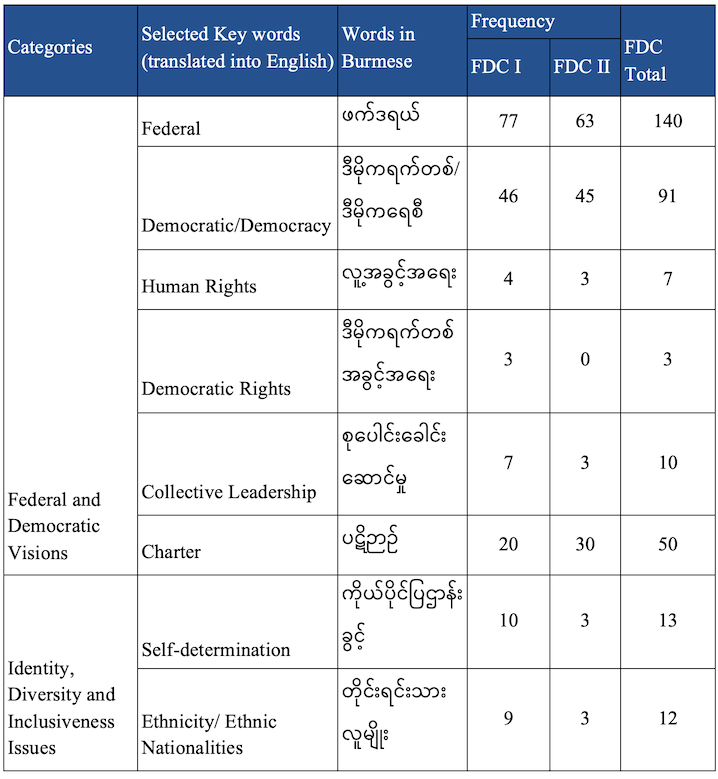

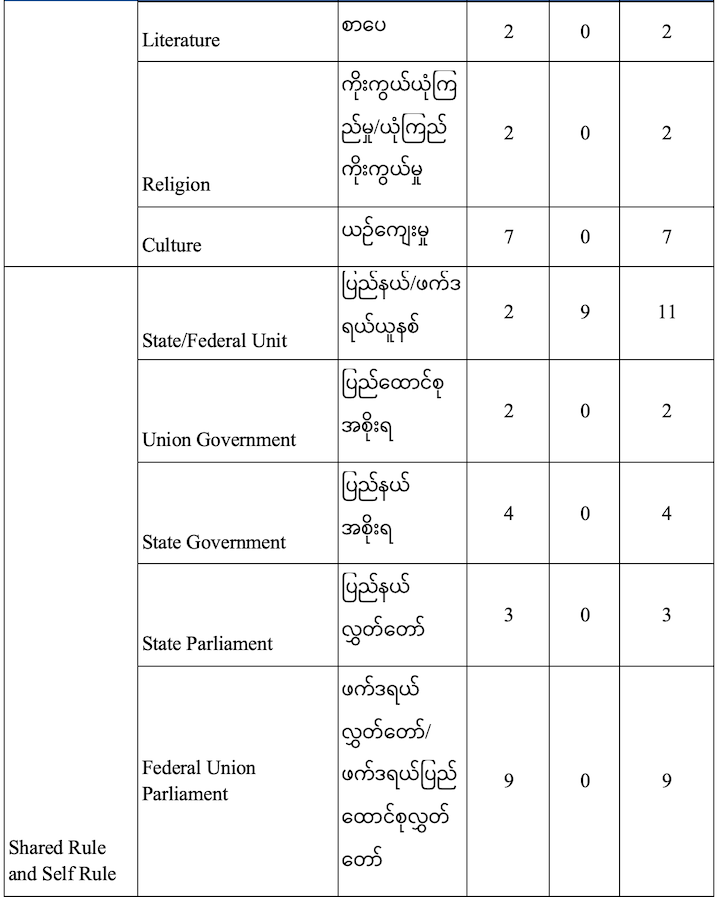
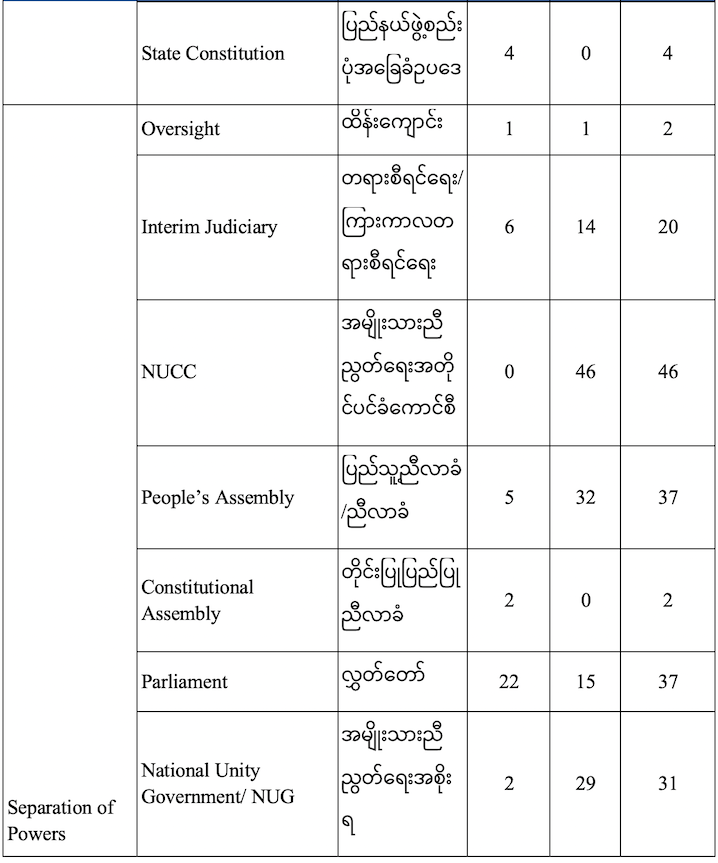
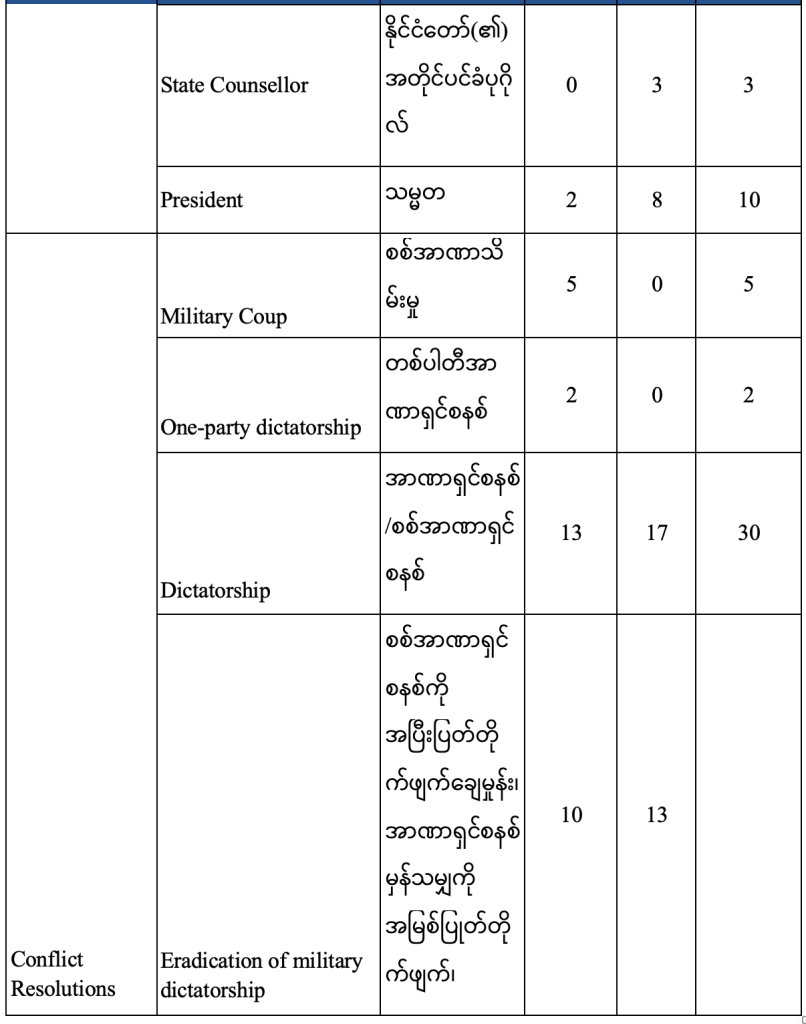

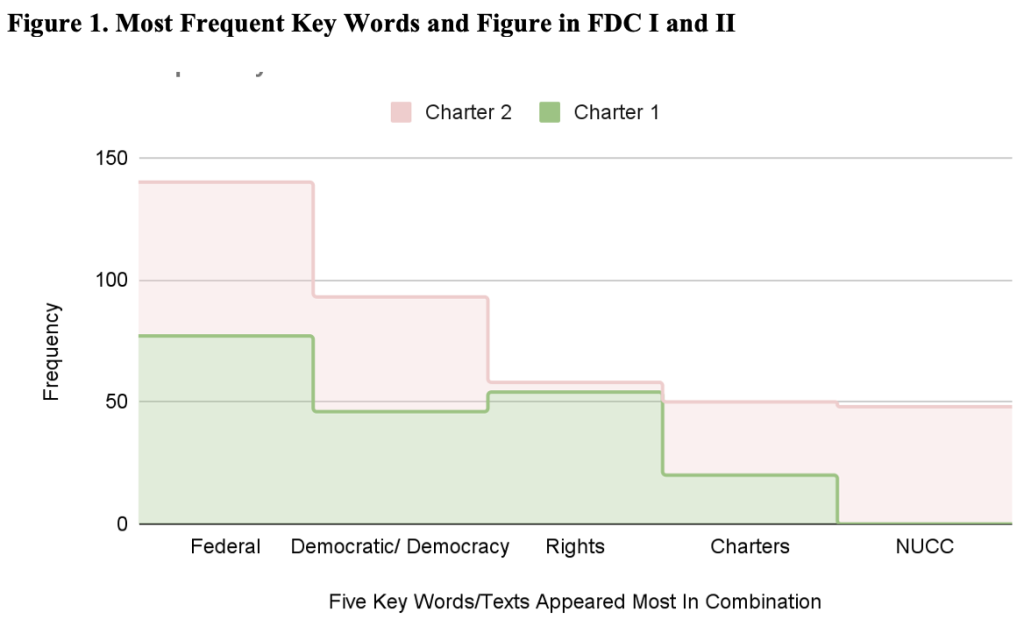
A quantitative content analysis of the documents reveals that the NUCC’s discussions, though contentious and heated, produced meaningful and fundamental sets of federal and democratic principles albeit that some elements reflected features of the 2008 Constitution. “Federal” is the most used term among those studied in both documents, 77 times in FDC I and 63 times in FDC II respectively. The second most frequent word is “democracy/democratic”, used 46 and 47 times in FDC I and II, respectively. Third most used word is “right(s)”, appearing 44 and 4 times in the respective documents. The words “Charter” and “NUCC” are the fourth and fifth words of highest use, appearing 50 and 46 times. In terms of individual documents, the word “rights” has the second-highest number of uses, 54 times, in Charter I; “NUCC” appears 46 times in FDC 2. The words, “self-determination” and “equality” appear 10 and 9 times in FDC I, but are mentioned only three times each in FDC II. The phrase, “eradicating military dictatorship” appears 8 and 13 times in FDC I and II, respectively. These are significant departures from the 2008 Constitution. Although that document used the word “democratic/democracy” 8 times in the entire document, there is nothing in its text that is fundamental to federal and democratic principles, as expressed through terms such as “federal”, “human rights”, “democratic rights”, “self-determination”, “minority”, or identity”.
The qualitative content analysis also offers a similar perspective to the quantitative content analysis. FDC I offers fundamentals of federal and democratic principles with the objectives of establishing a federal and democratic nation. It aims to implement four main processes: eradicate all kinds of dictatorship including military rule; abolish the 2008 Constitution; build a federal and democratic union; and call for the emergence of a civilian government. Part I differentiates itself from the 2008 Constitution by emphasizing its commitments to federalism in three components. It includes (1) the role of the state constitution in reflecting the shared rules/ shared sovereign aspects in federal principles, (2) the role of inter-governmental committees to settle disputes between states and between the federal government and the states, and (3) the relatively higher de jure power of state leaders, placed above union ministers in the official protocol.
FDC II also demonstrates considerable commitment to federal and democratic principles, highlighting the role of the NUCC and the People’s Assembly. It acknowledges the NUCC, composed of different political groups, as the body to provide policy leadership, and to oversee and coordinate different political groups in the period following the abolition of the 2008 Constitution. Where check-and-balance mechanisms are concerned, the NUCC is therefore accountable to the People’s Assembly. However, FDC II includes the role of a powerful state counsellor in the interim administration. The National League for Democracy (NLD) government first created this position to bypass the provision in the 2008 Constitution barring Daw Aung San Suu Kyi from becoming president of the country. Overall analysis of FDC I and II points to civilian authority over the military under a parliamentary system led by a prime minister. States are to enjoy significant powers and resources, shared with the union government.
PRACTICAL CONSTRAINTS: SEQUENCING PRIORITIES AND THE NATURE OF LEGITIMACY
Despite agreement on the fundamental federal and democratic values, there are different perceptions of how these values would translate into actual implementation plans. This section of the paper analyses two practical constraints faced in stakeholder dialogues within the NUCC.
Being a group with diverse stakeholders, the different sequencing priorities and different understandings of legitimacy in particular have slowed down the NUCC’s political development. As much as both parts of the FDC have become the backbone of the dialogue, they have also become the source of increasing disagreements. The rushed formation of the NUG before the completion of FDC II and the lack of clarity on the check-and-balance role of the NUCC caused concern in some stakeholders about the NLD-majority CRPH’s and NUG’s priorities for the NUCC.
In addition, some participants in the NUCC perceive legitimacy to be drawn from the landslide electoral victories gained by pro-democratic forces. These forces include representatives from the CRPH, the NUG, and the NLD and its supporters. At the same time, the long struggles for self-determination carried out by the ethnic resistance forces and ethnic political parties are considered by them to have won for them significant legitimacy from the ethnic communities they represent, as Finnigan (2019) once mentioned.[11] Other stakeholders, such as some leaders from civil society organizations and activist networks, who witnessed the conflicts between Bamar majority and ethnic minorities in the past decades tend to support such views.
Against this background, some stakeholders suggest that electoral representation be considered differently from political legitimacy, as some ethnic nationalities still support ethnic groups/leaders in their areas regardless of electoral representation. Likewise, there exists a strong view among NUCC stakeholders that the CRPH is made up of elected and legitimate representatives and should not be controlled by the NUCC.[12] These diverse perceptions of the nature of legitimacy complicate the discussion on the roles of the NUCC, the NLD-dominated CRPH and the NUG. Some view the NUCC dialogue process as being dominated by NLD members and their supporters rather than being an all-inclusive political dialogue and decision-making platform. These sequencing problems and different perceptions about legitimacy led to the withdrawal of some stakeholders from participation in the NUCC dialogue in October 2021. Although members have shared understandings of federal and democratic values, these setbacks became practical constraints hindering the NUCC dialogues from moving forward and putting these values into action for the interim governance arrangement.
SEEKING COMMON GROUND AND MAKING COMPROMISES
Despite hurdles, the NUCC has proven to be one of the significant achievements in the recent history of political alliances in Myanmar. Given the prolonged struggles against the military, failure by an emerging political platform such as the NUCC would cost the country its potential future political development. It is therefore a common understanding that preventing the NUCC from failing is critical.[13] In order to avoid the potential pitfalls arising from practical constraints, key stakeholders have demonstrated strong commitment to fight against the military through their incremental solutions. They have therefore reconsidered their approaches and revised their steps. In order to settle the issue of NLD overrepresentation in the NUCC, it has broadened its membership to include more political forces from diverse backgrounds[14] and limited the level of participation of the NUG in NUCC dialogues. It also seeks the role of providing policy guidance to the NUG as an attempt to solve the check-and-balance issue. These reforms within the NUCC have led to a gradual thaw in relations among its members.
CONCLUSION
Myanmar’s unpleasant history of incomplete nation- and state-building means that fighting the military and designing a federal and democratic system for Myanmar require tremendous efforts from all parties concerned. It is also a long-term undertaking. To be sure, just a year after the military coup, it is encouraging that shared values and visions have been established in principle by key stakeholders who enjoy political legitimacy and electoral representation within the NUCC. The newly released FDC I and II ratified by the NUCC reflect the commitment of stakeholders to federal and democratic principles, including acknowledging identity issues, shared rule, shared sovereign arrangements, separation of powers and the construction of a federal-based conflict management mechanism.
Nonetheless, it is at times worrisome to see that practical constraints often arise when it comes to implementing this federal and democratic vision within an interim governance arrangement. Indeed, building unity among stakeholders who share diverse interests and grievances is no easy task. The NUCC is currently drafting an interim constitution based on the FDC I and II. Stakeholders’ continuous strong commitment in the fight against the military in the immediate and mid-term and in building a solid foundation for a federal and democratic nation in the long term, and in making incremental compromises, would make this political coalition long-lasting.
ENDNOTES
[1] Bertil Lintner (1999). Burma in Revolt: Opium And Insurgency Since 1948, Routledge, pg. 210.
[2] As the NLD was the winning party, gaining 86% of civilian seats in both Pyithu Hluttaw and Amyotha Hluttaw, it representatives naturally holds the largest numbers in the CRPH. Likewise, three out of four ministers and an acting vice president of the interim government are NLD members.
[3] The Irrawaddy. (2 March 2021).Defying Military Regime, Myanmar’s CRPH Names Four Acting Ministers”, URL https://www.irrawaddy.com/news/defying-military-regime-myanmars-crph-names-four-acting-ministers.html.
[4] Reuters (13 March 2021). Vice-president of Myanmar civilian government vows resistance to junta rule. URL https://www.reuters.com/article/us-myanmar-politics-crph-idUSKBN2B50I0
[5] FDC 1 was drafted with reference to interim constitutional documents drafted in 1990 by NLD lawmakers and ethnic armed forces. FDC 2 was drafted in 2021 and ratified by the People’s Assembly in January 2022.
[6] Myanmar Now (16 April 2021). CRPH announces lineup of interim ‘national unity government’. URL https://www.myanmar-now.org/en/news/crph-announces-lineup-of-interim-national-unity-government
[7] Moe Thuzar & Htet Myet Min Tun (28 January 2022). “Myanmar’s National Unity Government: A Radical Arrangement to Counteract the Coup”. ISEAS Perspective 2022/8, URL /articles-commentaries/iseas-perspective/2022-8-myanmars-national-unity-government-a-radical-arrangement-to-counteract-the-coup-by-moe-thuzar-and-htet-myet-min-tun/
[8] CDM refers to a group of people who walked off their jobs to join the anti-junta movement.
[9] DAB is a multi-ethnic political alliance formed in border areas of the country in November 1988. It consists of most of the earlier alliance of EAOs, together with pro-democracy forces that took up arms against the military. This was one of the first alliances in which ethnic armed groups worked together with pro-democracy forces against military rule. Seekins, Donald M. Historical Dictionary of Burma (Myanmar). Rowman & Littlefield, 2017.
[10] NCUB is a group comprised of National Democratic Front (formed in 1976), DAB (1988), National League for Democracy Liberated Area (NLD-LA) (1991), and National Coalition Government of the Union of Burma -NCGUB (1996). Thawnghmung, Ardeth Maung. “The Karen Revolution in Burma: Diverse Voices.” In Uncertain Ends, Institute of Southeast Asian Studies, Singapore (2008).
[11] Finnigan, Christopher, 2019.Long Read: The politics of legitimacy in the Myanmar Peace Process, LSE South Asia Centre, URL: https://blogs.lse.ac.uk/southasia/2019/01/18/long-read-the-politics-of-legitimacy-in-the-myanmar-peace-process/
[12] Aye Chan, & Ford, B. (2021). A New Myanmar Forum Aims to Unite Democratic Forces. The USIP. URL https://www.usip.org/publications/2021/11/new-myanmar-forum-aims-unite-democratic-forces.
[13] Online Interviews with three individual members involved in NUCC stakeholder dialogue in different capacities (15-29 Janurary 2022).
[14] Nyan Hlaing Linn, (21, November, 2021). NUCC outlines goals as it seeks to widen membership, Myanmar Now, URL https://www.myanmar-now.org/en/news/nucc-outlines-goals-as-it-seeks-to-widen-membership

